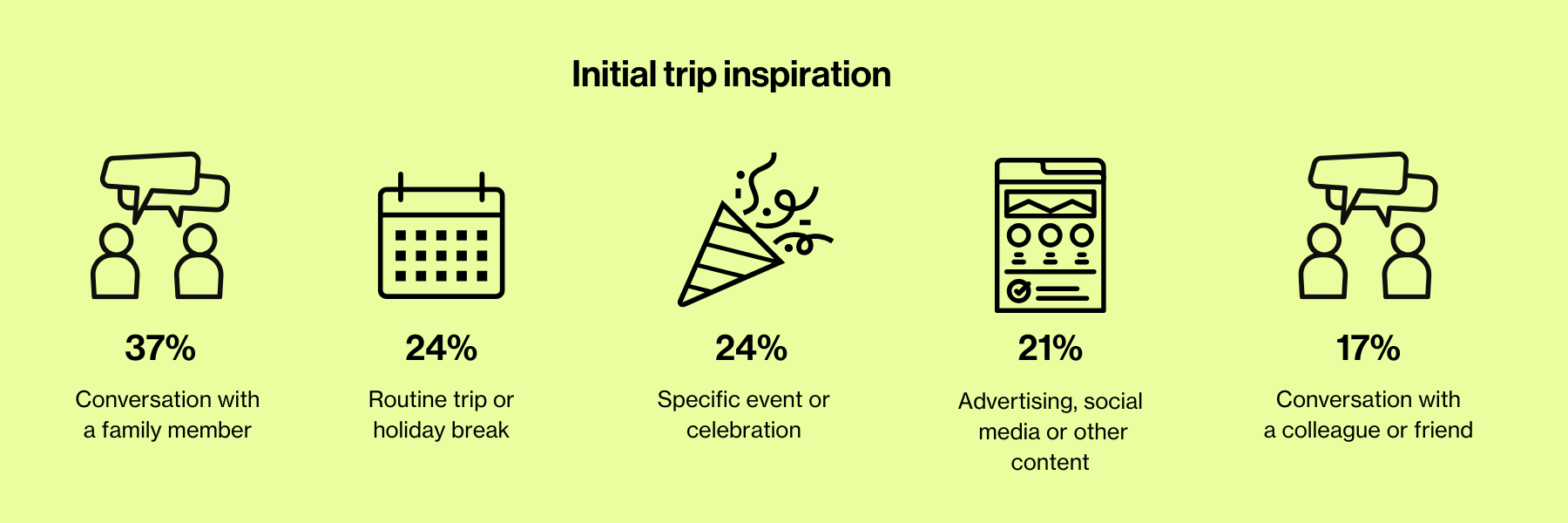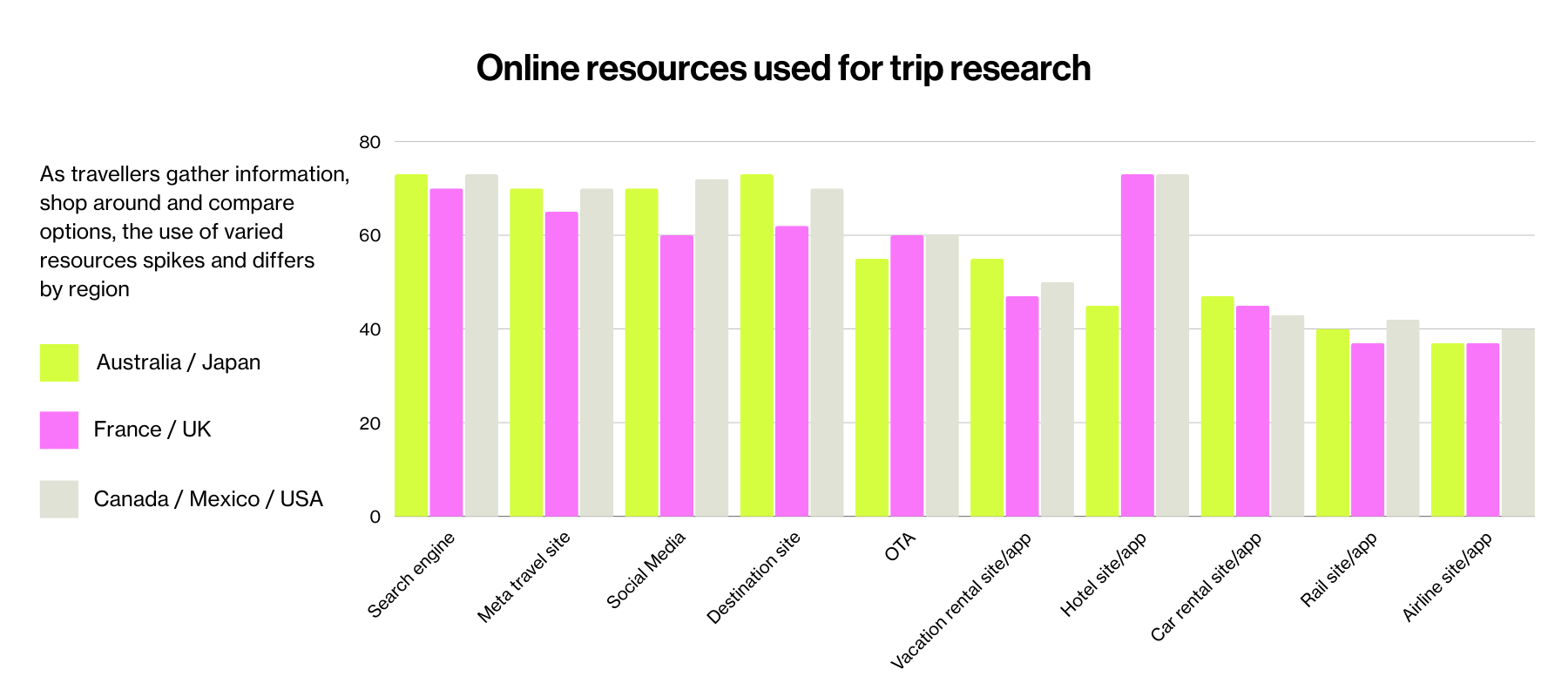
Competing for organic traffic in the travel and tourism industry
The travel and tourism industry is back with a boom following major disruption caused by the COVID-19 pandemic, but recovery is a long process for many brands. While demand is soaring, traveller needs and expectations have evolved. Meanwhile, brands face increased competitive, operational and financial pressures.
As a result, SEO and marketing teams need to prove the return on investment and the value of organic search as a key channel. In this guide, we explore the biggest challenges and opportunities for travel and tourism brands and how smaller players can compete against the industry giants.

Key challenges and opportunities
The industry is large and diverse, which means the priorities of one brand can be wildly different from another. So let’s take a look at the key SEO challenges and opportunities for the industry as a whole – and, then, at specific segments.
The industry finds some familiar challenges are even harder to deal with in the new normal:
Complex booking cycle: The travel planning and booking cycle is growing longer and more complicated, spread across traditional search, social media and a variety of booking apps.
Comparison and booking sites: The rise of travel comparison and booking sites opens new sources for travel bookings, but they also bring challenges – competition, fees, data loss, etc.
Ranking for competitive keywords: With the top comparison sites, booking apps and travel brands tending to dominate the SERPs for valuable keywords, building visibility for competitive queries is difficult.
Driving website traffic: With so much of the travel and booking cycle happening on third-party platforms, generating organic traffic is increasingly difficult.
Content production: Building visibility throughout a long, multichannel booking cycle requires a lot of content and the rise of video in travel marketing has only made this more challenging.
Direct vs indirect bookings: As travellers increasingly book through third-party sites and apps, travel brands need to balance the pros and cons of direct vs indirect bookings.
Multigenerational marketing: The travel interests, priorities and booking habits of Gen Z, millennials and other age groups vary greatly – so travel brands need a sophisticated, multigenerational marketing strategy to reach and convert each group.
Customer retention: The rise of DIY bookings makes customer retention harder for travel brands – and younger travellers are showing less interest in traditional loyalty incentives.
Online travel agents and tour operators
The obvious challenge for online travel agents (OTAs) and tour operators is dealing with the rise of DIY bookings – competing with booking sites and apps. People have all the tools they need to research, compare and book every aspect of their trips.
While some travel brands can generate business through these players, they’re direct competitors for travel agents. This means generating web traffic and ranking for competitive keywords is crucial for agents and operators as a way of securing direct bookings.
Many travel agents also have to cover a broad range of topics: packages, destinations, hotels, flights, insurance, etc.
Each key topic requires its own category page, which creates a relatively complex website structure. You also have to produce a lot of content for each topic. This creates a heavy workload for technical SEO and content production for many travel agents.
On the plus side, demand for travel agents has increased since the pandemic. So reaching the right audience and demonstrating the benefits vs other providers is key. For example, travellers are increasingly looking for lesser-known locations – a perfect example of how travel agents can help.
Hotels and accommodation
Hotels and short-term accommodation businesses have a different relationship with third-party booking sites. They can build visibility and secure bookings through platforms like Booking.com and Hotels.com.
Visibility on these platforms cuts right to the end of the booking cycle, too, where intent is at its highest. There are downsides, though. Aside from paying fees to booking platforms, the lack of data from indirect bookings is also a problem for travel brands that use these platforms.
There are downsides, though. Aside from paying fees to booking platforms, the lack of data from indirect bookings is also a problem for travel brands that use these platforms.
First of all, this leaves gaps in your analytics data, but it also makes it very difficult to reach out to previous customers and secure more bookings.
This is where balancing direct vs indirect bookings is key for any travel business using third-party platforms.
Airlines
Flights are the most price-sensitive purchase in the booking cycle with price being the top consideration for 63% of travellers. People are far more likely to scrimp on plane tickets and splurge on hotels and other luxuries during their trip.
This attitude drives a lot of travellers to price comparison sites and booking apps like Skyscanner. So, visibility on these apps is key, but the same downsides apply – especially when it comes to data loss and customer retention.
The other issue for airlines is that flights are often the first purchase travellers make. This means the booking cycle is relatively short compared to other travel purchases.
Airlines need to own the early inspiration, research and planning stage of the booking cycle. Competition from comparison and booking sites is particularly strong for airlines, too, due to the price sensitivity of flight bookings.
Indirect bookings are still valuable, but direct bookings are gold – especially when it comes to owning customer data to fuel loyalty programmes.
As a result, brand differentiation can be a key focus of SEO for airlines, highlighting competitive benefits such as quality of in-flight services and perks such as free baggage allowances and lounge access.
We’ll discuss this in more detail later when we explain how travel brands can use long-tail keywords to target specific travellers interests and differentiate from competitors.
Cruise lines and operators
The cruise market continues to show impressive growth after the post-pandemic recovery period. Crucially, demand is also increasing among younger travellers with the average age of cruise travellers falling, even as each generation grows older.
Gen Z and millennial cruise bookings are on the rise and multigenerational family bookings are a key driver of growth. Over 30% of bookings are families with at least two generations and 28% between three and five generations.
The good news is that the future looks bright for cruise bookings. The downside is cruise lines and operators need to implement a more multigenerational marketing strategy.
Each generation has different attitudes and priorities with travel, but they’re also using different channels and platforms throughout the booking cycle. So, you might reach baby boomers on Facebook, but you need a presence on TikTok and other platforms to reach Gen Z.
Seasonality impacts every travel business, but plays a unique and complex role in cruise operations. Of course, travel interests change throughout the year, but seasonality also affects factors such as the routes ships can take and the suitability of different ship sizes.
Amongst other projects for P&O Cruises, Vertical Leap, identified a seasonal opportunity for Scandinavian Trade, resulting in a 70% year-on-year increase in organic traffic.
This brings opportunities – for example, capitalising on the climatic differences of the Northern and Southern Hemispheres – but also challenges that are exacerbated by the unpredictability of climate change.
Regionality is also a key factor in SEO for cruises. First of all, you’re often dealing with different competitors in each region you operate in. At the same time, your target audiences will have varying priorities, based on the region they’re located in and the regions they’re interested in travelling to.
Tourist attractions
Tourist attractions are usually one of the first considerations in a travel booking or one of the very last.
For example, if people are booking trips to Disneyland, the attraction is the trip. In other cases, attractions like New York’s Empire State Building, Barcelona’s Sagrada Familia or Cambodia’s Angkor Wat spark the initial travel inspiration.
At the other end of the cycle, travellers are often busy looking for attractions and tours after they’ve booked their flights and hotels. In fact, many are still searching for attractions and things to do while they travel.
In this sense, the attraction booking cycle is as long as it gets but the peak stages are the early inspiration/planning and the post-booking stage.
The travel booking journey
The travel booking journey is long and complex, moving between a lot of channels. People are spending more time planning and researching their trips and they engage with a wider variety of content across more platforms.
Whichever travel niche you’re in, understanding how your audience navigates this booking cycle is key.
So, let’s delve into some insights into how people are booking their trips online.
The duration and timeline of travel bookings
According to insights from Expedia, the average travel purchase journey takes 71 days. This drops to 61 days for domestic trips and increases to 85 days for international trips.
That means your typical traveller spends two to three months navigating the four key stages of the booking cycle:
Crucially, once that first booking is made, the average duration before taking the trip is 73 days. During this time, travellers are in the market for all of the other bookings they haven’t made yet – hotels, tours, attractions, restaurant tables and similar reservations.
In a separate survey, 41% of international travellers make their first booking more than 12 weeks before they take off.
Expedia also finds that travellers spend 303 hours consuming travel content in the 45 days prior to their first purchase, visiting an average of 145 web pages.
During these 45 days, travellers interact with a wide range of channels – and none more so than online travel agents.
This highlights the opportunity for travel agents with a strong online presence – and other surveys offer similar insights. Wunderkind and Econsultancy data finds online travel agents top the list of places where travellers conduct research before making their first purchase (51%), followed by direct visits to travel brands’ websites or apps (39%).
Stage 1: Inspiration
Going back to the Expedia survey, social media is the key channel during the inspiration stage of the booking cycle. 77% of travellers say they use social media during the early inspiration phase, followed by online travel blogs and review sites at 49%.
This isn’t surprising, given that people spend most of their time online using social media – and two apps in particular. Globally, people spend 34 hours per month on TikTok and over 28 hours on YouTube compared to almost 20 hours on Facebook and 16 hours on Instagram.
Interestingly, though, social media isn’t always the first place people get that initial spark of inspiration for travel. That often comes from conversations with friends and family or seasonal events like Christmas and the summer holidays.
That being said, social media is the top digital source of travel inspiration, so visibility on the right platforms is crucial.
Social isn’t only a discovery channel, either. More people are using social as a search channel, particularly Gen Z and millennials who are using platforms like Instagram and TikTok to find local businesses and travel inspiration.
Stage 2: Research
As travellers enter the research stage of the booking cycle, search takes over as the most important channel. This is followed by “meta travel sites” like Skyscanner, Google Flights, Booking.com, etc.
Social media is the third most important channel at this stage, which reinforces the importance of visibility – both in terms of discovery and social search.
This includes visibility on online travel agents, too.
It turns out most travellers use online travel agents for planning trips, even if they book elsewhere. 80% visit at least one online travel agent website before making any purchase.
Crucially, 61% of people who book their hotel rooms directly from a hotel website used an online travel agent for research before making their booking.
Likewise, 52% of those who book flights directly from an airline and 58% who book directly from car hire firms use online travel agents before making the booking.
Stage 3: Planning
The planning stage typically starts once travellers choose their destination(s) of interest. At this point, they’re looking at flights, hotels, things to do and the finer details of their next trip.
Once again, the top channels shift at this stage with online travel agents taking the lead, followed by meta search sites and dedicated apps for car rentals, hotels, etc.
At the planning stage, we can see a more even spread across channels. This shows people are moving between platforms a lot during this stage of the booking cycle.
You can also see purchase intent is increasing as travellers use apps for specific booking purposes: hotels, flights, car hire, etc.
Stage 4: Booking
Various studies show that price is the top priority when travellers choose who to book with. More than half of travellers list this as the most important factor when booking flights and slightly less than half say pricing is their top concern for hotels, holiday rentals and packages.
So, yes, price competitiveness is important and this partly explains why online travel agents are the top channel (51%) for travel bookings. Aside from often being the cheapest place to book online, users can easily compare flights, hotels and other bookings.
Even still, a lot of travellers prefer to book directly from providers and operators: 37% from airlines, 23% from hotels and 13% from holiday rental websites/apps.
In fact, direct bookings on hotel websites were the third-biggest revenue channel from online bookings in 2023, according to Siteminder. Price competitiveness is still the key driver for booking directly from travel brands, as opposed to marketplaces – but it’s not the only reason.
Previous experiences are a key influence for 38% of travellers, showing just how important retention campaigns are for travel brands.
Meanwhile, 32% say brand reputation and reviews encourage them to book directly from travel brands. You’ve also got 22% saying brand values matter, which shows brand awareness and brand image are key to securing direct bookings from new customers.
Travel bookings are a big commitment – both financially and emotionally. Every industry survey and report shows there’s a sizeable market of people who want to book with confidence, even if it’s not the cheapest option.
Competing with the major booking sites
Competing with the major booking sites is one of the biggest challenges for most travel brands.
Even if you can secure bookings through these platforms, you’re still competing against them in the SERPs and always grappling with the pros and cons of direct vs indirect bookings.
So how can travel brands compete with the biggest names in the industry?
Spark travel inspiration and build brand recall on social media
As we saw earlier, social media is the top digital channel for travel inspiration. At the same time, Gen Z and millennials are increasingly using platforms like TikTok and Instagram as search engines. So, the line between search and social is getting thinner all the time for travel brands.
In terms of competing with major booking sites, strike a balance between the following strategies:
Inspiration: Spark the initial travel inspiration and implement strategies to nurture social leads along the booking cycle.
Brand awareness and recall: Put your brand front of mind for your target audience, so they think of you when the time comes to book – even if another brand sparked the initial inspiration.
Capturing leads at the inspiration stage is great if you can nurture prospects into bookings. Brand awareness and recall take time to achieve on social, but it can help you cut to the front of the queue when travellers make their bookings.
Take notes from Ryanair’s social media strategy as an example of building brand awareness and (especially) recall.
The airline constantly pokes fun at itself, travellers, social trends, global affairs and everything you could think of. It turns customer complaints and the quirks of travelling into running gaps.
It shamelessly makes unrelated stories about itself, too: sporting events, politics, the economy – you name it.
Most importantly, the biggest airline regularly goes viral for the wrong reasons – delays or quality of service, for example. Not as often as it's going viral for something the social media team has posted, though.
Few travel brands match Ryanair when it comes to brand awareness, brand recall or drowning out negative PR. For most people familiar with Ryanair’s social content, this is probably the first airline that comes to mind when they think of air travel.
Influence booking decisions with long-tail keywords
Search engines are most heavily used during the inspiration and research stages before travellers start prioritising online travel agents and booking sites.
Travellers also use the most long-tail keywords during these stages, as they seek inspirational and informational content. And, given the length of the travel booking cycle, long-tails help you reach more specific audiences whose needs align with your brand.
For example, you can target location long-tail keywords to reach audiences interested in your destinations.
You can also reach advanced and specific stages of the planning stage with long-tail location keywords – eg: “best areas to stay in Osaka,” “how to beat the crowds in Tokyo,” etc.
As travellers progress through the research and planning stages, long-tails become more commercial in nature. This is where you can start to promote your brand’s key selling points that differentiate you from the major booking sites.
Imagine an airline that wants to increase direct bookings from its website. They can target audiences weighing up direct bookings vs comparison sites and promote the advantages of booking directly with an airline.
Crucially, long-tails also help you cut through to specific stages of the booking cycle. Even if another brand sparked the initial travel interest on social media and someone spends hours using comparison sites, you can cut in at the late planning stage, just before they make the booking.
Yes, the travel booking cycle is complex, but it gives you a lot of opportunities to influence booking decisions.
Build off-site visibility in the right places
Off-site visibility helps you rank higher for competitive keywords, but it can also generate business from audiences you’re not reaching via SERPs.
Now, the “right places” are different for every travel brand, but here are some of the most common channels/platforms:
Booking apps: For many travel brands (airlines, hotels, holiday rentals, etc.), booking apps are the first place to build off-site visibility.
Local SEO: Build local visibility on Google Search, Google Maps, Business Instagram, TikTok, etc. – hotels are the obvious niche here, but local SEO is also important for travel agents, attractions and plenty of other travel brands.
Online reviews: As we saw earlier, reviews are a key influence in booking directly from travel brands, so build a positive reputation on platforms like Google Reviews, Trustpilot, Tripadvisor, etc.
Third-party websites: Get content published on travel websites and other niches (lifestyle, social, parenting, weddings, students, etc.) – start broad, don’t be afraid to get niche (corporate travel, honeymoons, gap years, etc.).
Online forums: Major travel forums like Tripadvisor and generic forums like Reddit and Quora are big opportunities for travel brands.
Aside from generating traffic and booking opportunities, earning quality backlinks is the other key purpose of building off-site visibility – something we’ll cover in more detail later.
Competitor and opportunity analysis
To compete against the major booking apps (and any rival in SERPs), you need to exploit their weaknesses. This starts with competitor analysis, to identify the strengths and weaknesses in their SEO strategy:
Identify their target keywords – what are they targeting and what are they missing?
Analyse their content – what kind of quality are you up against and what are their weaknesses?
Audit their website – what are their technical SEO and UX weaknesses?
Assess page quality – how well are they optimising for E-E-A-T on informational pages and YMYL on transactional or YMYL topic pages?
Audit their link profiles – identify their most valuable inbound links and look for opportunities they’re missing
Regularly perform competitor analysis to keep tabs on what’s working for them and what isn’t.
At the same time, travel trends are constantly changing, which opens up new keyword opportunities. Keep tabs on the latest trends and emerging keywords to optimise for new opportunities before the major booking apps pick up on them.
Content marketing for the travel booking cycle
Content marketing is particularly demanding for travel brands. Aside from having an unusually long and complex booking cycle to cover, you need a presence on a wide variety of platforms with different content formats.
Then, you’ve got the rise of video content that plays such an important role in travel marketing.
As a result, travel brands have to produce a high volume of quality, multimedia content for a complete marketing strategy. So, it’s no surprise that many travel marketers list content production as their biggest challenge.
For most travel brands, this means choosing the right content opportunities is crucial – and this starts with knowing your audience.
Analyse your audience’s path to purchase
Know who your target audience is and which platforms they use throughout the booking cycle. Map out the paths to purchase and determine which platforms and content they’re interacting with.
Figure out why they turn to each channel/platform as they navigate the booking cycle. For example, are they using online travel agents to make their bookings or are simply using them to compare prices before bookings directly?
Prioritise destinations and experiences early on
Put the spotlight on destinations and the allure of getaways to spark the initial travel inspiration.
People aren’t booking trips because they want to fly with a particular airline or stay at a specific hotel chain. They’re caught up in the fantasy of a perfect getaway and experiences they’ll remember for the rest of their lives.
So, focus on the destinations and the magic of travel experiences at the inspiration and early research stages.
Map keywords to search intent
Search takes over as the key channel during the research and planning stage – and this is where your keyword strategy makes all the difference.
Keep in mind that the research and planning stages make up the longest phase of the booking cycle.
This means travellers are performing a lot of searches during these phases. It also means that search intent progresses from informational, all the way to transactional with that first booking.
So, map your target keywords to the funnel and analyse search intent at every step. This is crucial for producing the right kind of content that not only provides what your audience is looking for, but also brings them one step closer to booking with you.
Nudge prospects in the right direction with helpful content
Give audiences what they need at each stage of the booking cycle – provide helpful content that encourages them to make booking decisions with confidence.
Optimise every page for E-E-A-T and, above all, make sure everything you publish is 100% accurate. Don’t let content quality drop after you publish pages, either. Regularly update your content to keep everything fresh, accurate and relevant.
For any transactional pages or content covering YMYL topics, optimise to the strictest E-E-A-T guidelines.
Gradually push your brand and key selling points centre stage
As travellers progress through the booking cycle, put more emphasis on promoting the brand, products/services and your key selling points.
If you’re a travel agent competing against booking apps, emphasise the quality of your services and the reassurance travellers get from booking with you.
If you’re a budget hotel in a famously expensive city, show travellers what they can do with all the money they save on their room.
Category pages and evergreen content
Category pages target your most important commercial keywords. For example, “flights to Paris,” “hotels in Rome,” etc.
You have to tick all of the right SEO boxes to get these ranking on page one: technical SEO perfection, quality backlinks, impeccable UX, E-E-A-T and YMYL (these pages are usually transactional).
You’ll also want to create evergreen content for your most valuable and competitive long-tails. Think of this as a long-term project where you create, optimise and update the best possible content for your biggest keyword opportunities.
Link building for travel and tourism brands
Quality backlinks are one of the most important ranking factors, especially when you want to compete for the most valuable keywords. Creating content that earns quality backlinks is easier said than done, though.
So, how can travel brands implement a content strategy that earns regular, quality backlinks?
Reports and surveys: Publish your own surveys and industry reports – websites are always looking for the latest stats to include in their content.
Editorial content: Write for publications as travel experts, offering insights, analysis and advice to their audience.
Guest posts: Seek guest post opportunities on relevant, high-authority websites.
Reactive content: Address the latest industry news and developments – particularly anything that affects your target audience (relevant publishers might want to link to or follow up for your input).
Press coverage: Get newspapers and other publications to write about you by being a newsworthy brand – for the right reasons.
Media networking: Build relationships with editors, journalists and media contacts who can reach out to you when they need input from an industry expert.
Thought leadership: Build your brand’s reputation as a trusted authority with unique insights, innovative ideas and helpful advice.
Content partnerships: Partner with authoritative websites to create joint studies, reports and other link-worthy content.
Citations: Chase up any valuable website that cites your brand/content without a link and ask them to include one.
Link intersect: Piggyback on successful competitor backlinks reaching out to websites with better content (guides, tools and calculators).
Co-op marketing: Plenty of travel brands are looking to team up with other companies and organisations for mutual promotion. For example, hotels with local attractions or airlines with car rental services.
Earlier, we saw that destination marketers say producing quality content is their biggest challenge. Creating content that earns backlinks is particularly difficult, but the rewards of a successful campaign are immense.
To add some context, loveholidays, one of the UK’s leading travel agents, approached us seeking help to build its organic search presence. After reviewing its website and competitors, we implemented a comprehensive link building strategy built around high-quality evergreen content.
We created roughly 30 content assets for the campaign, generating over 1,000 backlinks, including 18 links from .gov domains and 11 from .edu domains.
These links helped grow page one rankings for over 37,900 keywords and in turn increased organic traffic by +240%.
Local SEO for travel and tourism brands
From seeking destinations and comparing flights to booking hotels and things to do on holiday, local searches play a key role throughout the travel booking cycle.
Any travel brand with a physical presence in travel destinations (hotels, attractions, car hire companies, etc.) needs a local search presence.
Website localisation: Optimise your website for local SEO with location pages for each business premise.
Local schema makeup: Add local business structured data to each location page.
Google Business Profile: Complete and optimise your Google Business Profile.
NAP consistency: Make sure every citation including your business name, address and phone number is exactly the same.
Localised content: Create content for each business location targeting local keywords and the needs of travellers interested in the area.
Local backlinks: Target backlinks from local sources for each location page and localised content.
Directories: Add business listings to directory websites and any relevant niche directories like Tripadvisor.
Reviews: Build positive review scores on Google Reviews and other relevant platforms for each business location.
Localised content is an important part of any local SEO strategy, but it’s the bulk of topic coverage for most travel brands. Take a look at your target keywords and see how many of them don’t include an explicit location – especially at the planning and booking stages.
Keep in mind that travellers continue to perform local searches even while they’re on their trips. They’re still looking for things to do, attractions to see, places to eat, and so on.
The travel booking cycle only ends when holidaymakers land back in home territory.
Key takeaways and recommendations
The travel booking cycle is getting longer and more complex every year. This raises new challenges for travel brands, but it also brings more opportunities to connect with audiences and influence their booking decisions.
Here’s a quick summary of the key steps we’ve covered in this article to compete with big brands and win bookings from organic traffic:
Build visibility where your audience is most active at each stage of the booking cycle
Bridge the gap between social and search
Promote destinations and travel experiences first – then your brand and key selling points
Choose your keyword and content opportunities wisely
Target specific needs and search intentions with long-tail keywords
Cut in line by targeting keywords where the late planning and booking stages intersect
Build momentum with long-tail phrases while you optimise for more competitive keywords
Compete against bigger rivals by exploiting their weaknesses
Implement link building and digital PR to build domain authority and rank for competitive keywords
About the author
With over 18 years in the industry, Dave Colgate is Head of Enterprise SEO at our fellow Sideshow Group agency – Vertical Leap. Across both agencies, we've worked with numerous travel and tourism brands, including Audley Travel, Cunard, Gap 360, Forest Holidays, loveholidays, Original Travel, P&O Cruises and Skyscanner.
If you'd like to learn how Reddico could help you with your SEO contact us>
Sign-up to Reddico News
To keep up-to-date with the latest developments in the world of SEO, our insights, industry case studies and company news, sign-up here.







